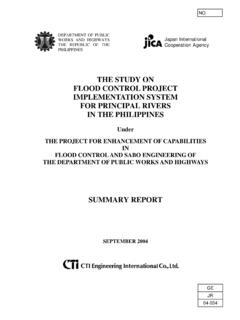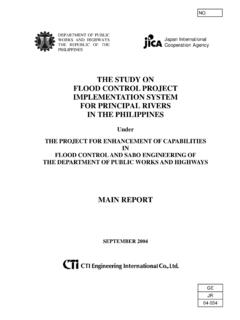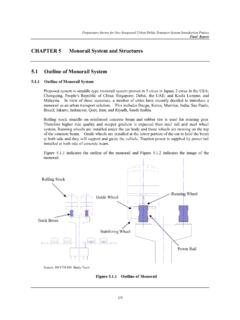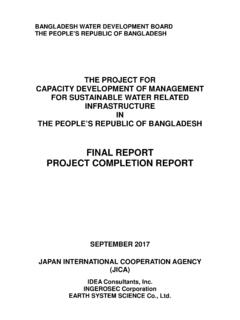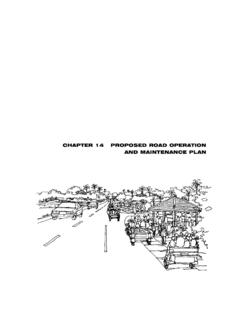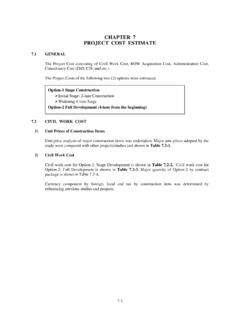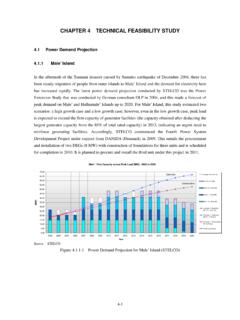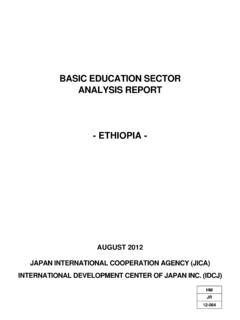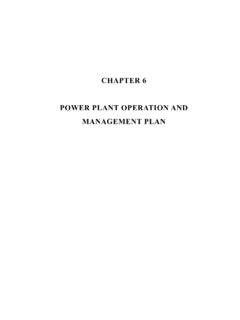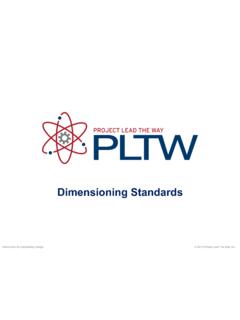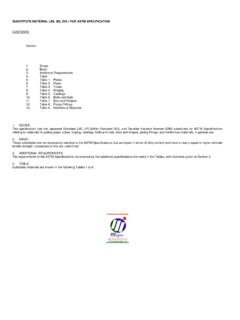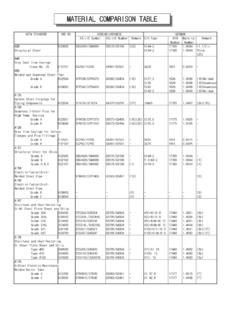Transcription of CHAPTER 3 RAILWAY TECHNICAL STANDARD
1 CHAPTER 3. RAILWAY TECHNICAL STANDARD . CHAPTER 3. RAILWAY TECHNICAL STANDARD . Purposes of Establishing RAILWAY TECHNICAL standards Specific rules and standards are necessary for railways to carry out safe, high-speed, punctual, and efficient train operation. Therefore, it is essential for the national government to clearly indicate standards on safety conditions and so forth so that railways can satisfy a specific level of social requirements by meeting the standards . The clarification of the TECHNICAL standards by the national government will enhance the transparency of national administration. Furthermore, various RAILWAY operators with different technological power, past achievements and so forth will become able to observe the standards and secure safety conditions and so forth higher than a specific level. The main purposes of establishing the RAILWAY TECHNICAL standards are as follow.
2 (1) Ensuring of safety One of the most important missions of RAILWAY enterprises is ensuring of safety. To secure RAILWAY safety, adequate education and training of personnel is necessary together with proper handling of train operation. Furthermore, it is also essential to ensure and maintain safe structure of facilities and rolling stock. In the RAILWAY TECHNICAL standards , therefore, the items concerning structure of facilities and rolling stock, train operation handling and so forth are stipulated for ensuring safety. (2) Maintaining of RAILWAY network and ensuring of RAILWAY transport characteristics To establish a RAILWAY network which enables through operation in the entire country or within large cities and to ensure advantageous RAILWAY characteristics such as large- volume, stable, and high-speed transport, it is necessary to maintain the conditions of facilities and rolling stock at a specific level.
3 In the RAILWAY TECHNICAL standards , therefore, items for ensuring the advantageous RAILWAY characteristics (curve radius, cant, steepest gradient, construction gauge, etc.) are stipulated. (3) Ensuring of convenience for users The conditions of facilities and rolling stock should be maintained at a specified level, in order to ensure comfortable and convenient RAILWAY utilization by customers and also to 3-1. enable easy use of railways by movement-constrained passengers. In the RAILWAY TECHNICAL standards , therefore, items concerning station facilities, transfer facilities, passenger cabin structure and so forth are stipulated for ensuring convenience for RAILWAY users. (4) Environmental countermeasures Although the RAILWAY is an environment-friendly means of transport, noise countermeasures for residents along its routes are necessary. In the RAILWAY TECHNICAL standards , therefore, such items as the adoption of track structure and rolling stock structure for noise reduction are stipulated.
4 (5) Reduction of production cost Regarding the RAILWAY facilities and rolling stock, it is effective to unify their production methods, test methods, dimensions, structure and so forth, in order to realize their quality improvement, production rationalization, production cost reduction and so forth. However, since these items should not be stipulated as compulsory standards by the national government, it is advisable for a federation of the enterprises concerned or a non-government organization to stipulate them as voluntary standards . Kinds of RAILWAY TECHNICAL standards RAILWAY TECHNICAL standards are broadly classified into: compulsory standards which stipulate safety and so forth; design standards which complement the compulsory standards ; and optional standards which aim at the enhancement of production efficiency, elimination of trade barriers, and so forth.
5 The details of these standards are as follows. Compulsory standards The governments and national railways of individual countries have established compulsory TECHNICAL standards on RAILWAY construction and operation, for such purposes as ensuring of RAILWAY safety and maintaining of RAILWAY networks. The titles of some of these standards centering on safety and so forth established in the countries of the world are as follows. Japan: Regulations on RAILWAY Structure Germany: Regulations on RAILWAY Construction and Operation 3-2. France: Official Administrative Regulations on Safety and Commercial Services on Nationwide and Regional RAILWAY Lines : RAILWAY Safety Principles and Guidance : FRA (Federal Railroad Administration) Regulations (State safety participation regulations, etc.). EU: EU Directives (COUNCIL DIRECTIVE 96/48/EC on the interoperability of the trans-European high speed rail system, etc.)
6 The framework of the compulsory RAILWAY TECHNICAL standards in Japan is as follows. In Japan, based on the framework of RAILWAY TECHNICAL standards , concrete items and contents of TECHNICAL standards have been stipulated. Safety Safety of passengers, Training of RAILWAY employees, slack, general public, RAILWAY cant, substations, operation safety employees devices, interlocking device, brake equipment, car body structure and so forth Policies Maintenance of network, Gauge, minimum curve radius, ensuring of RAILWAY steepest gradient, voltage and so forth characteristics Ensuring of Stable transport, Transition curve, vertical curve, convenience of enhancement of service station facilities, remote control RAILWAY users quality and comfort device, structure of passenger car and so forth Environmental Noise prevention Prevention of loud noise countermeasure Fig.
7 Framework of Compulsory RAILWAY TECHNICAL standards in Japan 3-3. Design standards Which Complement the Compulsory standards To formulate the contents of the compulsory TECHNICAL standards which stipulate such matters as safety, it is necessary to establish rules, from the stage of designing, concerning the strength of materials of facilities and rolling stock, safety level of structures, and so forth. If the designing and construction are carried out on the basis of these rules (design standards ), uniformed and reasonable structures and so forth throughout entire lines can be completed. Furthermore, the structures and so forth constructed on the basis of the prescribed design standards can be regarded as ones which satisfy the requirements on safety stipulated in the compulsory standards . In Japan, there are the following design standards for RAILWAY structures and so forth.
8 Design standards for RAILWAY structures and so forth Concrete structures Steel and composite structures Earth structures Basic structures and soil pressure-resisting structures Shield tunnel Steel-concrete composite structures Aseismatic design Earth structures for maintenance-free tracks Voluntary standards For industrial products, there are various international, regional, national, and group standards . The main purposes of these standards are to improve the quality of products, enhance production efficiency, rationalize production, reduce production costs, and eliminate trade barriers, by the unification of production methods, work methods, test methods, dimensions, structure, design methods, and so forth. There are similar standards for RAILWAY sectors as well, and each country is making efforts to adjust its regional, national and group standards to the national standards .
9 The voluntary standards for RAILWAY sectors are as follows. 3-4. (1) International standards 1) ISO (International Organization for Standardization). This is a nongovernmental organization consisting of representative organizations for standardization in individual countries, and has established international standards on all industrial sectors excluding electrical engineering sectors. As for the RAILWAY sectors, there are the following standards in the ISO standards 45. RAILWAY Engineering . RAILWAY engineering in general Materials and components for RAILWAY engineering RAILWAY rolling stock Rails and RAILWAY components Equipment for RAILWAY construction and maintenance 2) IEC (International Electrotechnical Commission). IEC has established international standards on electricity and electrical engineering sectors. As for the RAILWAY sectors, relevant standards are deliberated in the TECHNICAL Committee 9 (Electric RAILWAY equipment).
10 There are the following standards related to railways. IEC 60077 RAILWAY applications IEC 60349 Electric traction IEC 60494 Rules for pantographs of electric rolling stock IEC 60850 Supply voltages of traction systems IEC 61375 Electric RAILWAY equipment (2) Regional standards The European Committee for Standardization (CEN) and the European Committee for Electrotechnical Standardization (CENELEC) have jointly established unified standards EN (EURO NORM) for European countries. Some standards on RAILWAY sectors are included in the EN. (3) National standards Individual countries have respective organizations for standardization, in order to promote standardization of products and so forth in various industrial sectors. These 3-5. organizations have established national standards applicable to their countries. The national standards in main countries are as follows.
